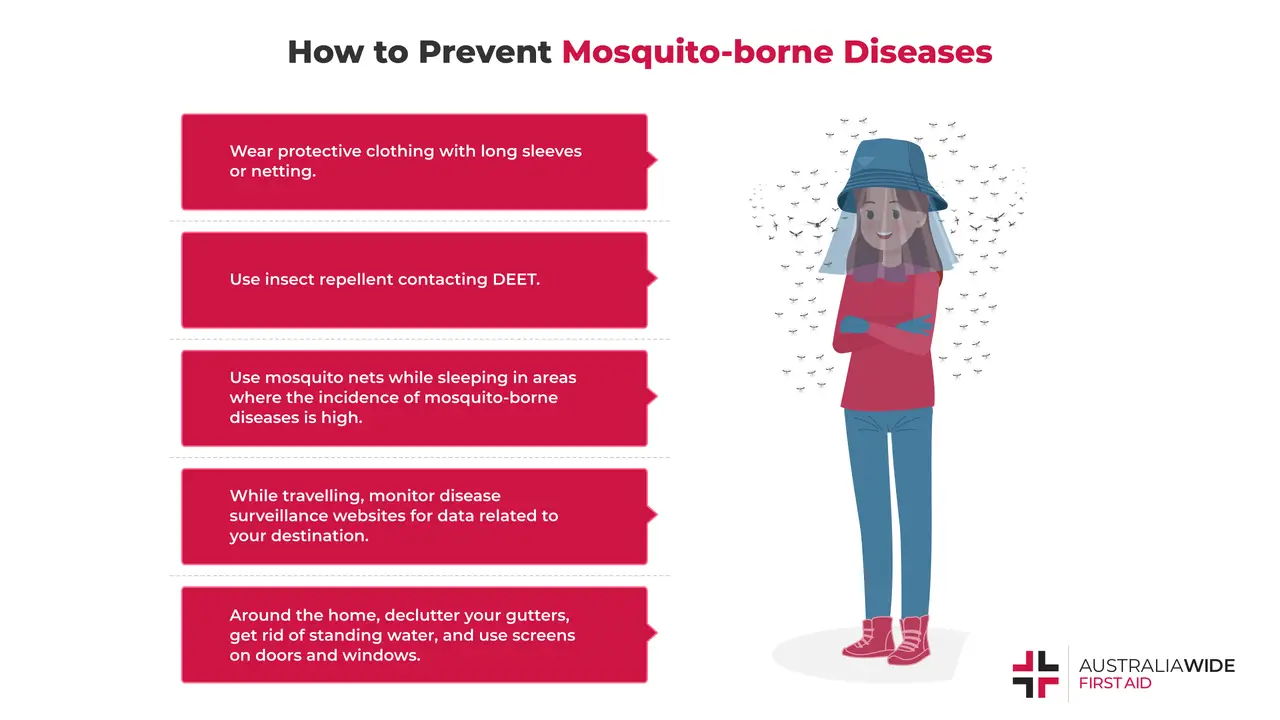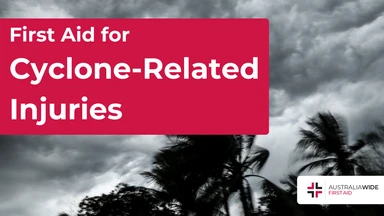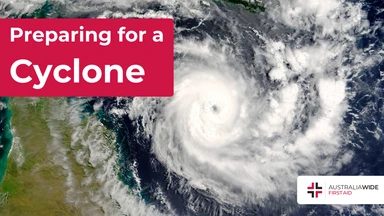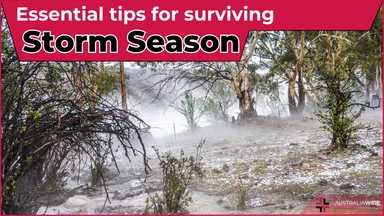Travel First Aid: Mosquito-borne Diseases


A mosquito-borne disease is any illness caused by a virus transmitted to a human from a mosquito bite.
Mosquito-borne diseases are acquired through mosquito bites. The mosquito acts as a vector that transmits viruses from one host organism to another organism. The mosquito is classified as a vector because it simply carries the virus rather than becoming ill from it and spreading it through classic contagion.
Mosquitos carry a wide variety of viruses that cause diseases in humans. But some are more prevalent than others, and travellers are likely at the most significant risk for acquiring a mosquito-borne infection. Summertime in Australia is one of the most popular seasons for travel to other countries, especially tropical destinations like Indonesia. Bali is a hotspot for the type of mosquito, Aedes aegypti, that hosts many mosquito-borne diseases.
The diseases reviewed below are commonly mild, but some people experience severe illness or prolonged symptoms. For that reason, mosquito-borne diseases are a worldwide health concern and worth learning about.
Organisations like the World Mosquito Program are educating, monitoring, and fighting the incidence of mosquito-borne diseases. According to their website, the organisation reports a 77% reduction in the transmission of dengue incidence in the areas that were treated using their ground-breaking method of introducing mosquitos into natural circulation that are unable to carry and spread the viruses.1
Although organisations are making great strides in the reduction of disease incidence, travellers and residents of high-incidence areas should protect themselves using education and prevention strategies. Below we will review four common mosquito-borne diseases: Dengue Fever, Zika Virus, Chikungunya, and Yellow Fever.
Dengue fever is caused by a virus transmitted by the Aedes aegypti mosquito. It cannot be transmitted from human to human – only to humans via a mosquito bite.
Symptoms typically last 2 to 7 days. Symptom onset can take up to 14 days post-transmission.
Symptoms include:
When severe, dengue fever can cause complications like dehydration, incapacitation, and dengue haemorrhagic fever. The very young, the very old, and those previously infected are at greater risk for severe illness.
Symptoms of severe illness include easy bruising, bleeding, abdominal pain, and difficulty breathing. These symptoms should be immediately evaluated by a healthcare provider. Severe illness with dengue fever can lead to death.
There is no vaccine or antiviral available. The treatment focuses on reducing the severity of symptoms using rest, fluids, and common over-the-counter medications. Avoid using NSAIDs (non-steroidal anti-inflammatory drugs) as they can increase the likelihood of bleeding.
Zika virus, or Zika fever, is caused by a virus and is commonly transmitted by the Aedes aegypti mosquito. It cannot be directly transmitted from human to human, only through a mosquito bite.
Zika is challenging to monitor and control because most people infected with the Zika virus do not show any symptoms. Those who do experience symptoms experience them to varying degrees. The symptoms can last anywhere between 2 and 7 days. Symptom onset can take up to 12 days post-transmission.
Symptoms include:
In pregnant women, the Zika virus can cause harm to babies in utero because it crosses the placental barrier. Babies born to mothers infected with Zika often have multiple medical problems, including severe disabilities caused by complications like microcephaly.
There is no vaccine or antiviral available. The treatment focuses on reducing the severity of symptoms using rest, fluids, and common over-the-counter medications and avoidance of travel to high-incidence areas when pregnant or planning to become pregnant.
Chikungunya is caused by a virus commonly transmitted by the Aedes aegypti mosquito. It cannot be directly transmitted from human to human. But if a mosquito bites an infected human, it can carry the virus to another human via a subsequent mosquito bite.
Symptoms of Chikungunya are very similar to dengue fever and Zika fever. However, it is marked by significant joint pain that can persist even after other symptoms have resolved. Most symptoms last 2 to 7 days. Symptom onset can take up to 12 days to occur.
Symptoms include:
The primary complication of Chikungunya is severe, persistent joint pain. For most people, symptoms from the disease, like joint pain, resolve within a week, but for others, the joint pain can persist for months or years.
There is no vaccine or antiviral available. The treatment focuses on reducing the severity of symptoms using rest, fluids, and common over-the-counter medications.
Yellow Fever can be transmitted to people in three ways, but all involve mosquito bites. Monkeys play a significant role in the continued reintroduction of infected mosquitos. Two types of mosquitos can transmit this virus – the Aedes aegypti and Haemogogus.
Yellow fever is particularly dangerous because of its haemorrhagic nature. It has the potential to cause life-threatening bleeding conditions.
Hundreds of thousands of people are infected every year with the virus that causes yellow fever. According to a 2019 fact sheet from the World Health Organisation, 30,000-60,000 people die annually.
Death is usually a result of kidney and liver failure, subsequent jaundice, and bleeding. Most people, however, have mild to moderate symptoms and recover within 3 to 4 days.
Symptoms include:
A yellow fever vaccine is available. It is incredibly effective, but it acts as a preventative measure and does not treat active yellow fever disease.
Treatment for yellow fever focuses on reducing the severity of symptoms using rest, fluids, and common over-the-counter medications. Avoid using NSAIDs (non-steroidal anti-inflammatory drugs) as they can increase the likelihood of bleeding.

Prevention is key to reducing the incidence of severe illness from mosquito-borne diseases. Some organisations, like the World Mosquito Program, are reducing incidence by releasing mosquitos into affected areas that cannot transmit illness-causing viruses.
Individually, we can do several things:
Many mosquito-borne diseases share similar symptoms. If you begin to feel ill after travelling, particularly after traveling to a tropical environment, have an assessment completed by your healthcare provider. Blood tests confirm many mosquito-borne diseases, and early monitoring can prevent severe illness.
When travelling, ensure that you are utilising prevention methods, as these are the most effective ways to reduce your likelihood of contracting a mosquito-borne disease.
If you enjoyed this article and want to learn more about first aid, check out the Australia Wide article library for more resources. Taking a first aid course can help prepare you in case of illness or emergency.

March 3, 2025
Injuries during cyclones often result from flying debris, collapsing structures, and flooding. Knowing basic first aid can help prevent further harm while waiting for emergency services.

March 3, 2025
If a cyclone makes landfall, meaning that it crosses from the sea onto land while still being strong enough to be classified as a cyclone, the damage it can cause can be disastrous. Preparation is key to minimising the risks associated with cyclones. The damaging weather can last for days, exacerbating risks as hazards intensify.

November 1, 2024
Severe storms are a common and dangerous occurrence in Australia, particularly in regions like Queensland. These storms can bring large hail, damaging winds, heavy rain, and occasionally tornadoes, all of which can put both people and property at risk. Preparing for and responding to severe storms effectively is key to ensuring safety.